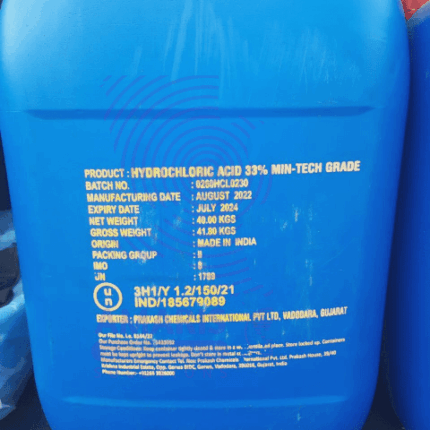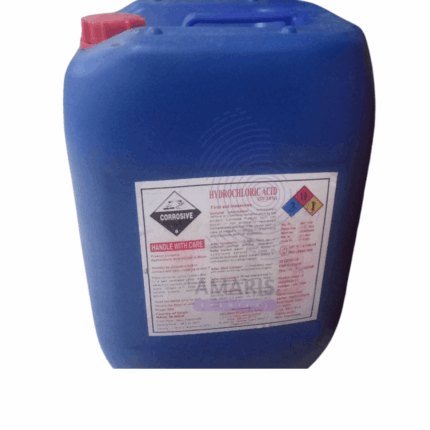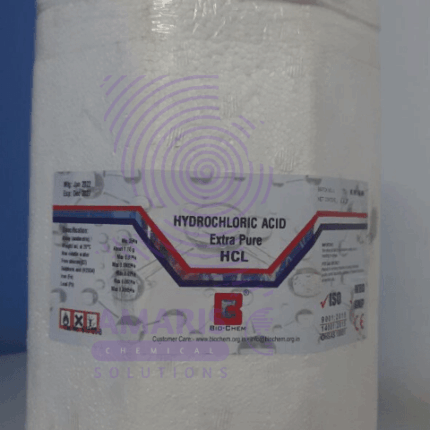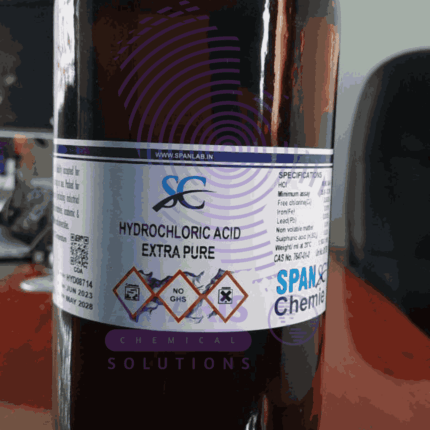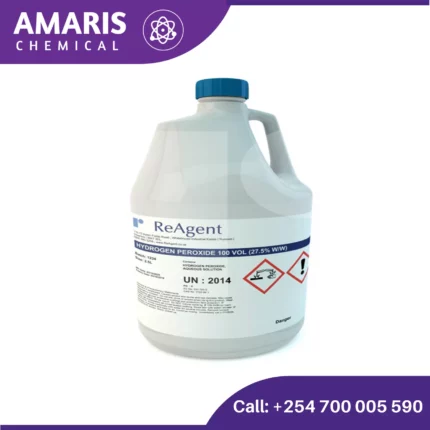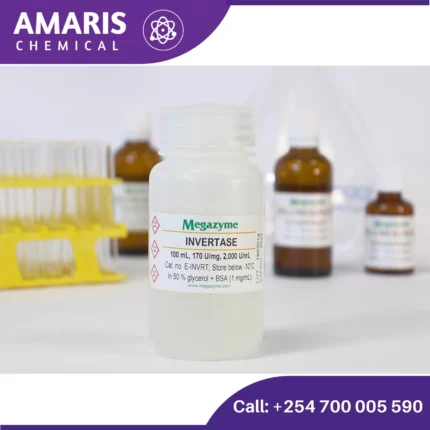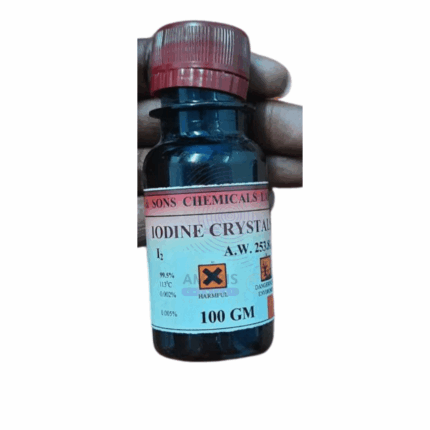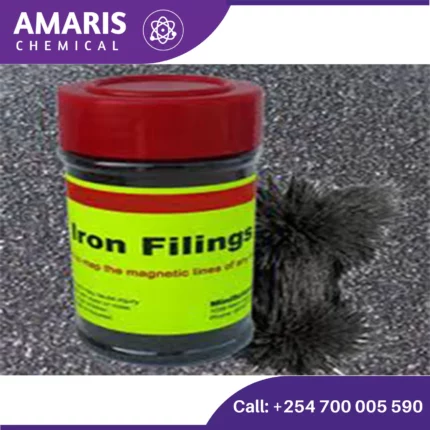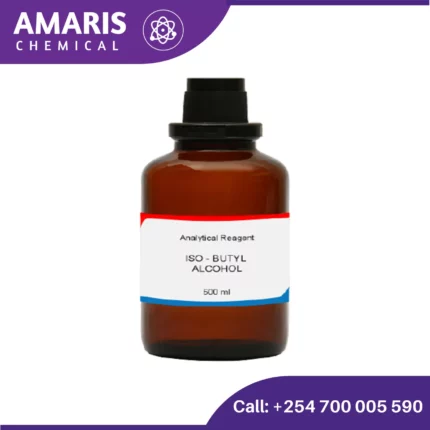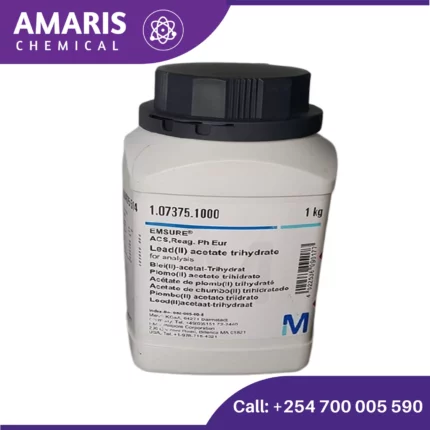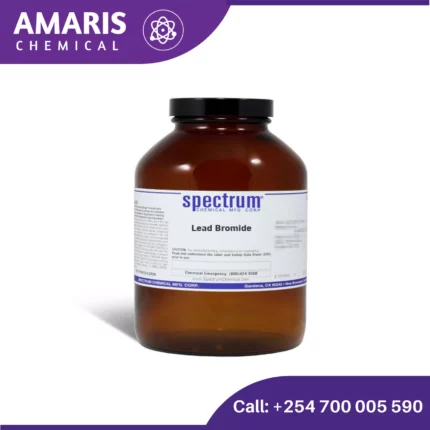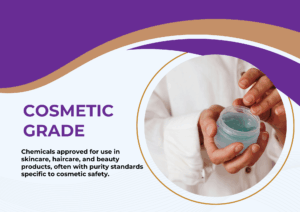Hydrochloric Acid ( HCL ) 40 kg
Hydrochloric acid (HCl) is a strong, colorless, and highly corrosive acid that is widely used in industry and laboratory applications. It is a solution of hydrogen chloride gas in water and is commonly known as muriatic acid. Hydrochloric acid is a highly reactive compound that can dissolve many metals and organic materials, and it is also an important component of the gastric acid in the stomach, where it helps in the digestion of food. Hydrochloric acid has a pungent odor and can cause severe burns and eye damage if handled improperly. It is commonly used in the production of PVC plastics, fertilizers, and various other chemicals, and it is also used in the petroleum industry for the removal of impurities from oil and gas wells.
Hydrochloric Acid 2.5litre extra pure
Hydrochloric acid (HCl) is a strong, colorless, and highly corrosive acid that is widely used in industry and laboratory applications. It is a solution of hydrogen chloride gas in water and is commonly known as muriatic acid. Hydrochloric acid is a highly reactive compound that can dissolve many metals and organic materials, and it is also an important component of the gastric acid in the stomach, where it helps in the digestion of food. Hydrochloric acid has a pungent odor and can cause severe burns and eye damage if handled improperly. It is commonly used in the production of PVC plastics, fertilizers, and various other chemicals, and it is also used in the petroleum industry for the removal of impurities from oil and gas wells.
Hydrogen Peroxide 2,5litres extra pure
Hydrogen peroxide is a chemical compound with the molecular formula H2O2. It is a colorless and odorless liquid, which appears slightly more viscous than water. Hydrogen peroxide is a powerful oxidizing agent, meaning that it readily releases oxygen atoms in chemical reactions. It is commonly used as a disinfectant, bleaching agent, and in the production of other chemicals. In its pure form, hydrogen peroxide is highly reactive and can be dangerous, but when properly diluted, it can be used safely for a variety of applications.
Immersion Oil 50ml
Immersion oil is a specialized oil used in microscopy to enhance the clarity and resolution of images observed through high-power objective lenses. It has a refractive index similar to that of glass, reducing light refraction and increasing the amount of light reaching the microscope's objective lens. This allows for greater detail and higher magnification of microscopic specimens. Typically, immersion oil is used with 100x oil-immersion objectives, and it's essential for achieving the highest possible image quality in certain types of microscopy.
Iodine Tincture 100ml
Iodine tincture is a topical antiseptic solution containing iodine in alcohol. It's commonly used to disinfect skin before surgery, injections, or other procedures. The alcohol helps the iodine penetrate the skin quickly, where it acts to kill bacteria, fungi, viruses, and other microbes. It's recognizable by its dark brown color and distinctive antiseptic smell.
Isobutyl Alcohol 500gm
Isobutyl alcohol, also known as 2-methylpropan-1-ol or isobutanol, is a clear, colorless liquid with a characteristic odor that resembles that of rubbing alcohol. It has a molecular formula of C4H10O and a molecular weight of approximately 74.12 g/mol. Isobutyl alcohol is soluble in water and miscible with most organic solvents.
Physical Properties:
- Odor: Isobutyl alcohol has a distinct, mildly alcoholic odor.
- Density: Its density is about 0.802 g/cm³ at 20°C.
- Boiling Point: The boiling point of isobutyl alcohol is around 108.6°C (227.5°F).
- Flash Point: It has a flash point of 27°C (80.6°F), making it flammable.
- Miscibility: Isobutyl alcohol is miscible with water and many organic solvents.
- Isobutyl alcohol contains a hydroxyl group (-OH) attached to a carbon atom in a branched chain structure, which affects its solubility and reactivity.
- It can participate in various chemical reactions, including oxidation and esterification processes.
Lactose Monohydrate 500gm
Lactose monohydrate is a crystalline form of lactose, a disaccharide sugar composed of glucose and galactose. In its monohydrate form, each lactose molecule is associated with one water molecule, resulting in a hydrated crystalline structure. This white to off-white, odorless powder is widely used in various industries for its functional properties. As a key component of milk and dairy products, lactose monohydrate serves important roles in pharmaceuticals, food manufacturing, and biotechnology. It is commonly employed as a filler or binder in pharmaceutical tablets and capsules, as well as a sweetening agent and texture enhancer in the food industry. The monohydrate form of lactose provides versatility in applications, contributing to its widespread use in different sectors.
Lead Bromide 500gm
Lead BromideLead bromide (PbBr₂) is an inorganic compound consisting of lead and bromine. Here are some key details about lead bromide:
Properties:
- Chemical Formula: PbBr₂
- Appearance: White crystalline solid
- Molar Mass: 367.01 g/mol
- Melting Point: 373 °C (703 °F)
- Boiling Point: Decomposes before boiling
- Density: 6.66 g/cm³
- Solubility in Water: Poorly soluble (1.03 g/100 mL at 20 °C)


